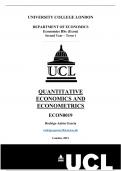Resumen
ECON0019 (Quantitative Economics and Econometrics) Term 1 Summary - UCL Economics BSc Second Year
- Grado
- Institución
- Book
Summary of Term 1 taught in ECON0019 (Year 2021/2022) Detailed notes from lecture notes, textbooks and other materials. Topics covered include: 1) Simple Linear Regression (SLR), 2) Multiple Linear Regression (MLR), 3) Finite Sample Inference in MLR, 4) Large-Sample Inference in MLR, 5) MLR w...
[Mostrar más]



